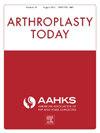达尔巴万星在骨与关节感染中的应用
IF 1.5
Q3 ORTHOPEDICS
引用次数: 0
摘要
背景达巴万星(DAL)用于治疗骨和关节感染的标示外使用有所增加,尤其是在不需要长期静脉注射的情况下。这项回顾性、单中心、描述性研究纳入了在 4 年内(2019-2023 年)使用 DAL 治疗骨或关节感染的成人患者。研究收集了患者的人口统计学特征、感染类型和部位、DAL 前的抗生素和手术治疗、DAL 的适应症以及临床结果。结果共有58例患者接受了DAL治疗后发生骨和/或关节感染。大多数患者接受治疗的原因是骨髓炎(81.0%),其次是本关节感染(8.6%)和假体周围关节感染(10.4%)。50例(86.2%)患者接受了手术治疗,25例硬件感染患者中有17例(68%)完全切除了硬件。最常见的病原体是金黄色葡萄球菌(41;70.7%),其中 23 例(40.0%)分离出耐甲氧西林金黄色葡萄球菌。10例(17.2%)患者在一年内复发。研究发现,移除假体能明显降低感染复发的风险(P = .026)。结论:我们的研究结果表明,在结合手术清创和硬件移除的情况下,DAL是治疗骨关节感染的有效方法。未移除受感染的硬件会显著增加一年内感染复发的风险。需要进行随机对照试验,以进一步支持 DAL 作为骨科感染的新型治疗方法。本文章由计算机程序翻译,如有差异,请以英文原文为准。
Dalbavancin Use in Bone and Joint Infections
Background
Dalbavancin (DAL) off-label use for treating bone and joint infections has increased especially as long-term intravenous access is not needed. Little is known about the effectiveness and safety of its use.
Methods
This retrospective, single-center, descriptive study included adults treated with DAL for bone or joint infections over a 4-year period (2019-2023). Patient demographics, infection type and location, pre-DAL antibiotic and surgical treatments, indication for DAL, and clinical outcomes were collected. Risk factor analysis for 1-year infection recurrence was performed.
Results
There were 58 patient encounters of bone and/or joint infections treated with DAL. The majority of patients were treated for osteomyelitis (81.0%) followed by native (8.6%) and peri-prosthetic (10.4%) joint infection. Fifty (86.2%) patients underwent surgical intervention, and 17 (68%) of the 25 patients with infected hardware had full hardware removal. The most common pathogen identified was Staphylococcus aureus (41; 70.7%), with methicillin-resistant Staphylococcus aureus isolated in 23 (40.0%) cases. Ten (17.2%) patients had recurrence within 1 year. Hardware removal was found to significantly decrease the risk of infection recurrence (P = .026). None of the peri-prosthetic joint infection patients had infection recurrence within 1 year.
Conclusions
Our findings support DAL as an effective treatment for bone and joint infection when combined with surgical debridement and hardware removal. Failure to remove infected hardware significantly increased the risk of infection recurrence within 1 year. Randomized controlled trials are needed to further support DAL as a novel treatment for orthopedic infections.
求助全文
通过发布文献求助,成功后即可免费获取论文全文。
去求助
来源期刊

Arthroplasty Today
Medicine-Surgery
CiteScore
2.90
自引率
0.00%
发文量
258
审稿时长
40 weeks
期刊介绍:
Arthroplasty Today is a companion journal to the Journal of Arthroplasty. The journal Arthroplasty Today brings together the clinical and scientific foundations for joint replacement of the hip and knee in an open-access, online format. Arthroplasty Today solicits manuscripts of the highest quality from all areas of scientific endeavor that relate to joint replacement or the treatment of its complications, including those dealing with patient outcomes, economic and policy issues, prosthetic design, biomechanics, biomaterials, and biologic response to arthroplasty. The journal focuses on case reports. It is the purpose of Arthroplasty Today to present material to practicing orthopaedic surgeons that will keep them abreast of developments in the field, prove useful in the care of patients, and aid in understanding the scientific foundation of this subspecialty area of joint replacement. The international members of the Editorial Board provide a worldwide perspective for the journal''s area of interest. Their participation ensures that each issue of Arthroplasty Today provides the reader with timely, peer-reviewed articles of the highest quality.
 求助内容:
求助内容: 应助结果提醒方式:
应助结果提醒方式:


